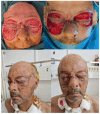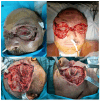Multidisciplinary Approach in Rare, Fulminant-Progressing, and Life-Threatening Facial Necrotizing Fasciitis
- PMID: 39584844
- PMCID: PMC11587011
- DOI: 10.3390/idr16060084
Multidisciplinary Approach in Rare, Fulminant-Progressing, and Life-Threatening Facial Necrotizing Fasciitis
Abstract
(1) Background: Necrotizing fasciitis is known as a severe condition with a high risk of mortality, placing it among the most feared infections. In most cases, it has a polymicrobial etiology (type 1), requiring complex treatment that is continuously adapted to the evolving microbiological status. The facial localization of the disease is rare, fulminant progressing, and is often life-threatening. (2) Methods: We present the case of a patient with multiple comorbidities who, following trauma to the nasal dorsum, developed a wound with a rapid and severe progression to extensive bilateral periorbital necrosis. This was accompanied by a dramatic deterioration in their general condition, a polymicrobial biological status, and fluctuating progression despite instituted treatment (both medical and surgical). (3) Results: The patient required multiple surgical interventions by multidisciplinary teams (plastic surgery; ear, nose, and throat specialist (ENT); maxillofacial surgery; and ophthalmology), experiencing periods of a severe, life-threatening general condition, necessitating prolonged orotracheal intubation. Wounds with fluctuating progression, extensive skin necrosis, and significant post-excisional soft tissue defects required skin graft coverage. The result meant a saved life and functional and aesthetic sequelae at the level of the face. (4) Conclusions: Necrotizing fasciitis of the face is a rare and severe disease that must be recognized early and treated appropriately by a multidisciplinary team to save the patient's life and minimize the resulting functional and aesthetic sequelae.
Keywords: debridation; facial trauma; fulminant progression; necrotizing fasciitis; reconstructions.
Conflict of interest statement
The authors declare no conflicts of interest.
Figures








References
Publication types
LinkOut - more resources
Full Text Sources
Research Materials
Miscellaneous

